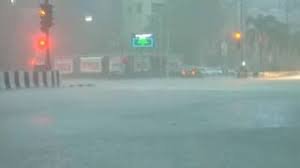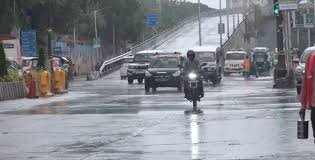
Heavy rainfall returned to Mumbai on Monday morning, causing serious disruption in many parts of the city. The India Meteorological Department (IMD) issued red and orange alerts for different areas, warning residents about possible flooding, traffic problems, and disruption in daily life. Local authorities and emergency teams were placed on high alert as the city faced another tough day during the monsoon season.
The IMD has issued a red alert for some areas of Mumbai, especially in low-lying regions where waterlogging is a common issue. A red alert means that the rainfall will be very heavy, and people should stay indoors unless absolutely necessary. Other parts of the city, including suburbs and nearby districts like Thane and Navi Mumbai, are under an orange alert, which means heavy to very heavy rain is expected.
According to the weather department, Mumbai may receive more than 200 mm of rainfall in 24 hours in certain areas. This amount of rain can easily flood roads, affect railway lines, and slow down daily life. The forecast also warns of strong winds and lightning in some areas, making it more dangerous for people to travel, especially on bikes or on foot.
As soon as the rain began early in the morning, roads started to flood in several parts of South Mumbai, including areas like Dadar, Parel, Sion, and Byculla. People shared pictures and videos on social media showing cars stuck in deep water, pedestrians walking through knee-deep water, and buses moving slowly through flooded streets. In some places, water entered houses and ground-floor shops, creating difficulties for residents and small businesses.
Train services, the backbone of Mumbai’s transport system, were also affected. Local trains on the Central and Western lines were running late due to water on the tracks. Many office-goers complained of delays and cancellations, especially during the morning rush hour. Some trains were diverted, and a few services were even suspended in the worst-hit areas. The Brihanmumbai Municipal Corporation (BMC) requested residents to avoid unnecessary travel and work from home if possible.
The Mumbai Police and disaster response teams were actively managing the situation. They were seen helping vehicles stuck in flooded roads and guiding traffic to avoid waterlogged areas. The fire brigade received several calls from people trapped in their homes or vehicles. Thankfully, there were no major accidents or injuries reported at the time of writing, but officials urged people to stay alert and follow safety guidelines.
Schools and colleges were advised to remain closed in some parts of the city, especially in areas under the red alert. Parents were informed early in the morning through official messages, and online classes were suggested where possible. Many students and parents welcomed this decision, as travel during heavy rains can be risky for young children.
The Chhatrapati Shivaji Maharaj International Airport in Mumbai also experienced delays. Some incoming flights were delayed due to poor visibility and wet runways. A few short-haul flights were rescheduled. Airport authorities issued a statement saying that flight operations were being monitored closely and safety measures were in place.
Experts say that Mumbai is likely to face more such heavy rain events in the coming days, as the southwest monsoon gains strength. The June to September monsoon period is always a challenging time for the city, but climate change and rapid urban development have made things worse in recent years. Concrete roads, blocked drains, and illegal construction have reduced the city’s ability to deal with heavy rains.
Environmentalists have long warned that Mumbai’s natural drainage system, including rivers and wetlands, is being destroyed. As a result, even normal rainfall causes waterlogging in many areas. The city’s Mithi River, which flows through several densely populated areas, is often clogged with garbage and construction waste, leading to frequent overflows during monsoon rains.
The BMC has been working on several projects to prevent flooding, such as cleaning drains before the monsoon, improving pumping stations, and widening the Mithi River. However, many citizens feel that these efforts are not enough. They demand better planning, stronger rules against illegal construction, and real-time information about weather and traffic during such emergencies.
Social media played a big role in spreading updates. Mumbaikars used platforms like X (formerly Twitter) and Instagram to share rain conditions in their areas. Many used hashtags like #MumbaiRains, #MumbaiWeather, #RedAlertMumbai, and #MumbaiFloods to stay informed and help others avoid trouble spots. Citizens also praised Mumbai’s spirit, as many people helped strangers stuck in water or shared umbrellas and rides.
Despite the heavy rains and disruptions, Mumbai once again showed its resilience. People continued their day with caution, showing their usual determination to keep the city moving. But the rain also reminded everyone about the importance of better infrastructure and planning.
In response to the alert, the BMC opened control rooms in every ward to assist residents. People were asked to report waterlogging, power cuts, or fallen trees through the BMC helpline or WhatsApp number. Disaster response teams, including the National Disaster Response Force (NDRF), were kept ready in case of emergencies. Hospitals were told to prepare for any rain-related health cases, like waterborne diseases or injuries from slips and falls.
The weather department has advised residents to stay indoors, avoid going near the sea, and keep emergency items like food, water, flashlights, and mobile chargers ready. Fishermen were also advised not to venture into the Arabian Sea due to high waves and rough conditions.
Mumbai residents are used to dealing with heavy rain, but today’s conditions reminded many of the July 2005 flood, when the city received over 900 mm of rain in a single day. That disaster led to hundreds of deaths and huge damage to property. Since then, awareness has grown, but the city still struggles every monsoon season.
The government has promised better forecasting systems and more funds for rain-related infrastructure, but citizens say the work must be faster and more transparent. Heavy rainfall is becoming more frequent due to climate change, and cities like Mumbai must be prepared to deal with such events.
For now, authorities continue to monitor the situation and hope the rain will slow down by the evening. Residents are urged to avoid travel, stay safe, and follow updates from trusted sources like the IMD, BMC, and Mumbai Police.

































